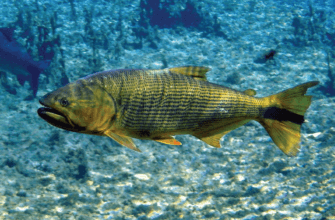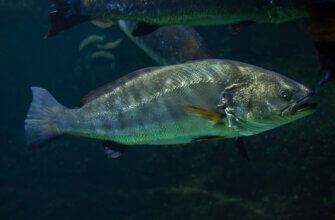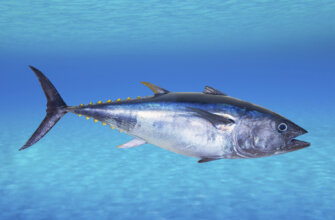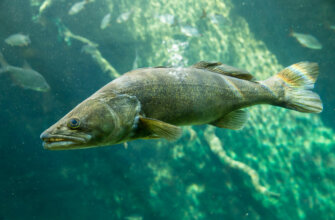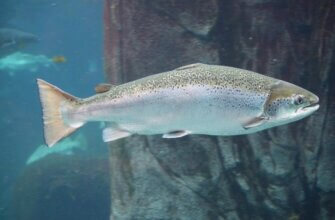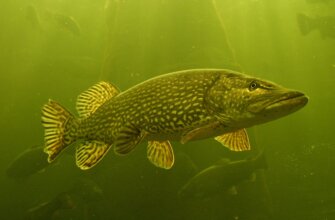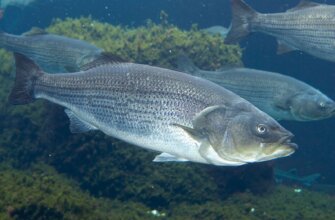Bluegill is a species of freshwater fish that belongs to the sunfish family (Centrarchidae). Its scientific name is Lepomis macrochirus. Bluegill are native to North America and are widely distributed throughout the United States and Canada. They are commonly found in lakes, ponds, rivers, and reservoirs.
Bluegill have a characteristic deep, laterally compressed body with a dark olive-green color on their upper body and yellowish-green on their sides. They have a black spot at the base of their dorsal fin and a bright orange to yellow breast and belly. The name “bluegill” refers to the blue coloration found on the gill covers and the bright blue hue that can appear on the cheeks and chin of males during the breeding season.
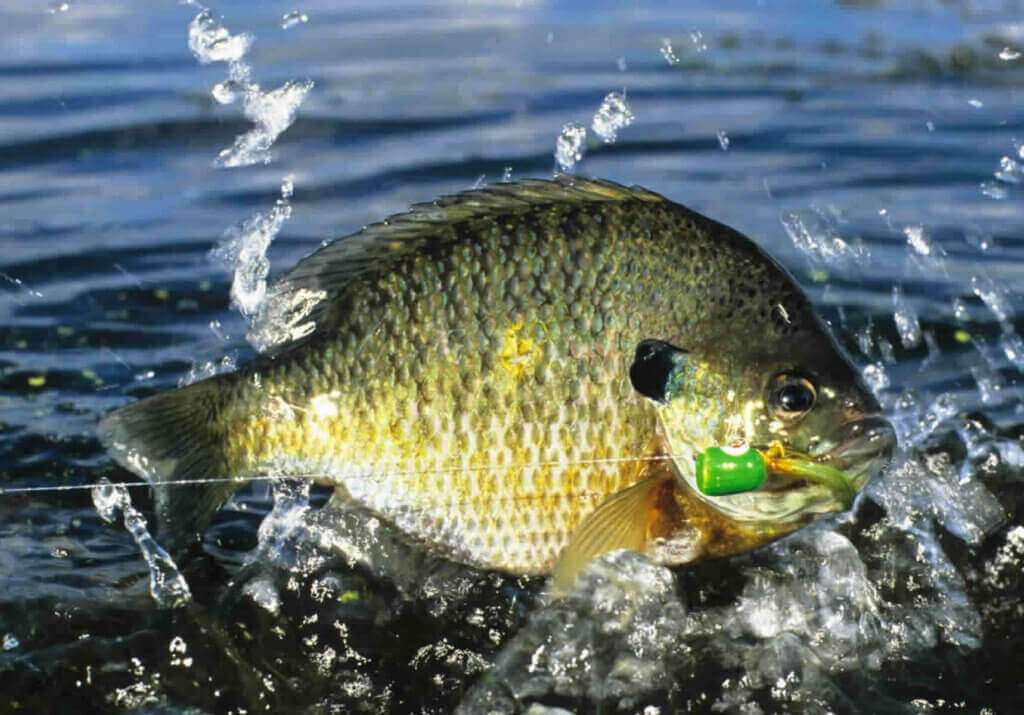
Bluegill are popular among anglers due to their willingness to bite, making them a common target for recreational fishing. They are also an important forage species for larger predatory fish. Bluegill feed on a varied diet that includes insects, crustaceans, small fish, and aquatic vegetation.
In some cases, bluegill have been introduced outside of their native range, leading to concerns about their impact on local ecosystems. They are considered invasive in some areas where they have been introduced, as they can outcompete native fish species for resources and disrupt the balance of aquatic ecosystems.
Overall, bluegill are a well-known and widely appreciated species of freshwater fish, valued for both their recreational and ecological significance.
Species
Here are some additional details about the species Bluegill (Lepomis macrochirus):
- Habitat: Bluegill are primarily found in freshwater environments such as lakes, ponds, reservoirs, rivers, and streams. They prefer warm, quiet waters with plenty of vegetation, submerged logs, or other forms of cover.
- Distribution: Bluegill are native to North America and have a wide distribution across the continent. They can be found throughout the eastern and central United States, as well as parts of southern Canada. Due to their popularity as a sport fish, they have also been introduced to other regions of the world.
- Reproduction: Bluegill typically spawn during the spring and early summer when water temperatures reach around 70 to 75 degrees Fahrenheit (21 to 24 degrees Celsius). During spawning, males create nests by fanning the bottom substrate using their fins. Females lay their eggs in these nests, and males guard and protect the eggs and fry until they hatch.
- Feeding Habits: Bluegill are opportunistic feeders and have a diverse diet. They primarily consume aquatic insects, insect larvae, small crustaceans, and zooplankton. They also feed on small fish, fish eggs, and aquatic vegetation. Bluegill have small, sharp teeth that allow them to grasp and consume their prey.
- Social Behavior: Bluegill are social fish and often form loose aggregations or schools, especially during the non-breeding season. They exhibit a hierarchical social structure, with larger individuals occupying more dominant positions. They are known to be territorial, particularly during the spawning season.
- Fishing and Aquaculture: Bluegill are highly sought after by recreational anglers due to their abundance, ease of catching, and good taste. They are commonly caught using various fishing techniques, including bait fishing, fly fishing, and spin casting. Bluegill are also frequently raised in aquaculture systems for food or stocking in private ponds and fisheries.
- Hybridization: Bluegill can hybridize with other closely related species, such as pumpkinseed sunfish (Lepomis gibbosus) and green sunfish (Lepomis cyanellus). These hybrid offspring can have different characteristics and behaviors compared to pure bluegill.
Bluegill are an iconic and ecologically important fish species in North America, contributing to both recreational and conservation efforts.
Appearance
The bluegill (Lepomis macrochirus) is a species of freshwater fish native to North America. It is a member of the sunfish family and is known for its vibrant colors and distinctive appearance.
Here are some details about the appearance of a bluegill:
- Size. Bluegills typically measure between 4 to 10 inches (10 to 25 centimeters) in length, although some individuals can grow larger under ideal conditions.
- Shape. Bluegills have a deep, laterally compressed body shape. They have a rounded profile with a slightly pointed snout.
- Coloration. Bluegills display vibrant colors, especially during the breeding season. The body is typically olive-green or blue-green on the upper side, fading to yellow or silver on the lower side. The sides of the fish feature a series of vertical bars that are typically a shade of blue or black, giving the species its name.
- Fins. Bluegills have a dorsal fin, which is located along the middle of the back, and an anal fin, which is located on the ventral side near the tail. Both fins have spines at the front followed by soft rays.
- Operculum. The operculum is a bony flap covering the gills on each side of the fish’s head. In bluegills, the operculum is typically dark-colored with a pattern of wavy lines.
- Tail. The tail of a bluegill is moderately forked, with rounded lobes. The coloration of the tail is similar to the rest of the body.
- Scales. Bluegills have small, thin, and cycloid scales that cover their body. These scales are usually a shade of green or olive, helping to blend in with their environment.
Overall, bluegills have a beautiful and distinctive appearance with their colorful body, vertical bars, and characteristic shape. These features make them a popular and recognizable species among anglers and fish enthusiasts.
Size and weight
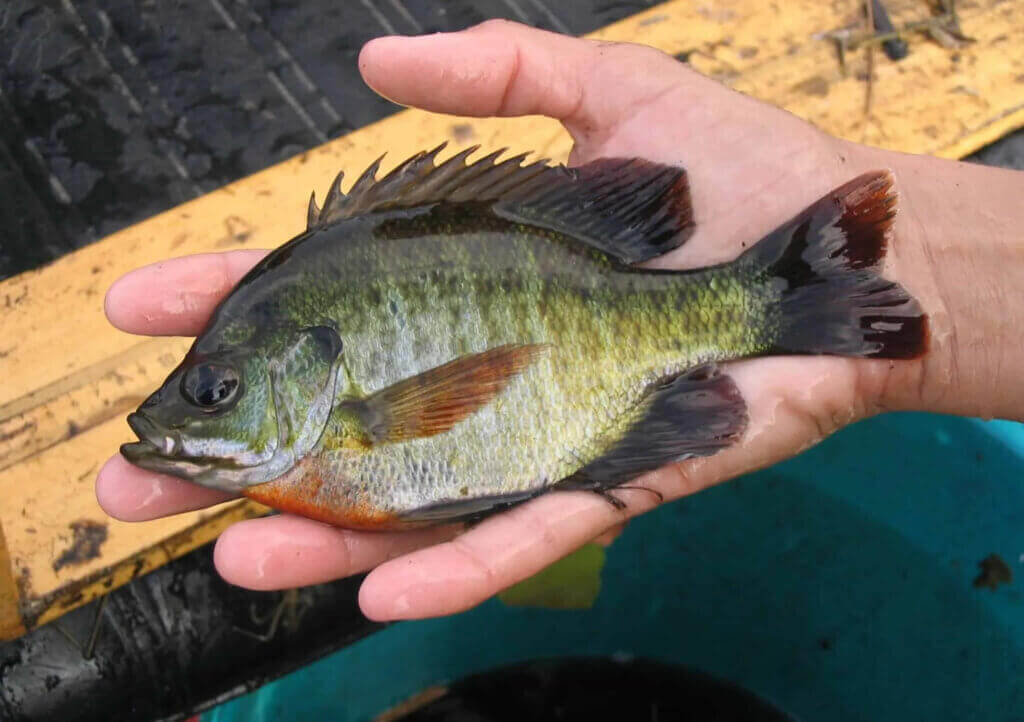
The Bluegill, scientifically known as Lepomis macrochirus, is a species of freshwater fish native to North America.
Size:
- Bluegill typically range in size from about 4 to 10 inches (10 to 25 centimeters) in length.
- The average size of an adult Bluegill is around 6 to 8 inches (15 to 20 centimeters).
Weight:
- The weight of Bluegill can vary depending on several factors such as age, habitat, and availability of food.
- On average, adult Bluegill usually weigh between 0.5 to 1 pound (0.2 to 0.5 kilograms).
- In some exceptional cases, larger Bluegill can weigh up to 2 pounds (0.9 kilograms) or more.
It’s important to note that these size and weight ranges are general approximations, and there can be variations among individual fish and different geographical locations. Bluegill are a popular sport fish and can provide enjoyable angling experiences for many fishing enthusiasts.
Diet
In the wild, bluegill primarily feed on aquatic insects, small crustaceans, and zooplankton. They also consume smaller fish, fish eggs, and larvae. Additionally, bluegill feed on aquatic vegetation such as algae, aquatic plants, and even terrestrial insects that fall into the water.
When it comes to their diet in captivity, bluegill can be fed a balanced diet that mimics their natural feeding habits. Commercially available bluegill feeds are commonly used in aquaculture operations to provide the necessary nutrients for the fish. These feeds are usually formulated to contain a combination of plant proteins, fishmeal, vitamins, and minerals.
It’s important to note that bluegill can adapt to a wide range of diets, and their nutritional requirements may vary depending on their age and size. Providing a diverse diet that includes both live or frozen food (such as brine shrimp, bloodworms, and daphnia) and a high-quality pelleted feed can help ensure the proper nutrition of bluegill in captivity.
Behavior
Bluegill, scientifically known as Lepomis macrochirus, exhibit various behaviors that are characteristic of sunfish species.
Here are some details about the behavior of bluegill:
- Social Structure – bluegill are social fish and often form loose aggregations or schools. These schools can consist of individuals of different ages and sizes. Within the school, there is usually a dominance hierarchy established, with larger and more aggressive individuals occupying the higher ranks.
- Feeding Behavior – bluegill are opportunistic feeders and actively forage for food. They are often found near the shorelines of lakes, ponds, and slow-moving rivers, where they feed on a wide range of food sources. Bluegill use a sit-and-wait approach to hunting, lurking near vegetation or structure and ambushing prey when it comes within striking distance.
- Reproduction – bluegill exhibit complex reproductive behaviors. During the breeding season, which typically occurs in spring and early summer, males construct circular nests in shallow water by sweeping away debris and creating depressions on the lake or pond bottom. Once the nests are prepared, males court females by displaying their bright colors and engaging in a variety of behaviors, including fin displays and nest defense. Females select a male and deposit their eggs in the nest, where they are fertilized by the male. After spawning, males guard the nest and the newly hatched fry until they are able to swim and feed on their own.
- Territoriality – bluegill can be territorial, especially during the breeding season. Males guard their nests and the surrounding area, aggressively defending them against intruding fish or other threats. This territorial behavior helps protect the eggs and young fry from predators.
- Response to Environmental Stimuli – bluegill are responsive to environmental cues. They are known to adjust their behavior in response to changes in light intensity, water temperature, and food availability. For example, they may move to deeper waters during periods of extreme heat or seek out warmer areas in colder months.
- Solitary Behavior – while bluegill often form schools, they also engage in solitary behavior. During certain times, such as when seeking shelter or feeding in secluded areas, individuals may separate from the school and exhibit solitary tendencies.
It’s important to note that individual bluegill behavior can vary based on factors such as habitat, population density, and environmental conditions. The behaviors mentioned above provide a general understanding of bluegill behavior, but specific observations in local populations may reveal additional nuances.
Spawning
The spawning behavior of bluegill (Lepomis macrochirus) is an interesting and important aspect of their life cycle.
Here are some details about the spawning behavior of bluegill:
- Breeding Season. Bluegill typically spawn during the spring and early summer months, when water temperatures reach around 70 to 75 degrees Fahrenheit (21 to 24 degrees Celsius). The exact timing may vary depending on the geographic location and local environmental conditions.
- Nest Building. Male bluegill play a significant role in nest building. They construct circular nests in shallow water, usually near the shoreline or in areas with submerged vegetation. The nest-building process involves the male sweeping away debris and creating a small depression on the lake or pond bottom. They use their fins and mouths to move pebbles, gravel, or small plant material to create a saucer-shaped nest.
- Courtship and Spawning. Once the nest is prepared, male bluegill actively court females to encourage them to deposit their eggs in their nest. The courtship display includes the male displaying vibrant colors, expanding its fins, and making fin displays to attract the female’s attention. Males may also engage in head-bobbing or quivering behaviors as part of the courtship ritual. Females choose a male based on the quality of the nest and the male’s displays.
- Egg Deposition. After a female selects a male, she approaches the nest and deposits her eggs into the nest cavity. The male releases milt (sperm) to fertilize the eggs as they are laid. The female may deposit multiple batches of eggs in different nests with different males.
- Nest Guarding. Once the eggs are fertilized, the male bluegill takes on the responsibility of guarding and defending the nest. He remains near the nest and aggressively chases away potential threats, including other fish, predators, or intruding bluegill. The male’s protective behavior helps ensure the survival and development of the eggs.
- Egg Development and Hatching. The fertilized eggs are adhesive and stick to the nest substrate. The male continues to guard the nest and fan water over the eggs, which helps provide oxygen and prevent fungus growth. The incubation period typically lasts around 4 to 7 days, depending on water temperature. Once the eggs hatch, the fry remain in the nest for a short period until they are capable of swimming and feeding on their own.
It’s worth noting that bluegill are prolific spawners, and a single male can build and guard multiple nests simultaneously. This reproductive strategy maximizes the chances of successful reproduction and survival of their offspring.
Observing the spawning behavior of bluegill can be a fascinating experience, as it showcases the intricate courtship rituals and parental care displayed by these fish during the breeding season.
Fishing
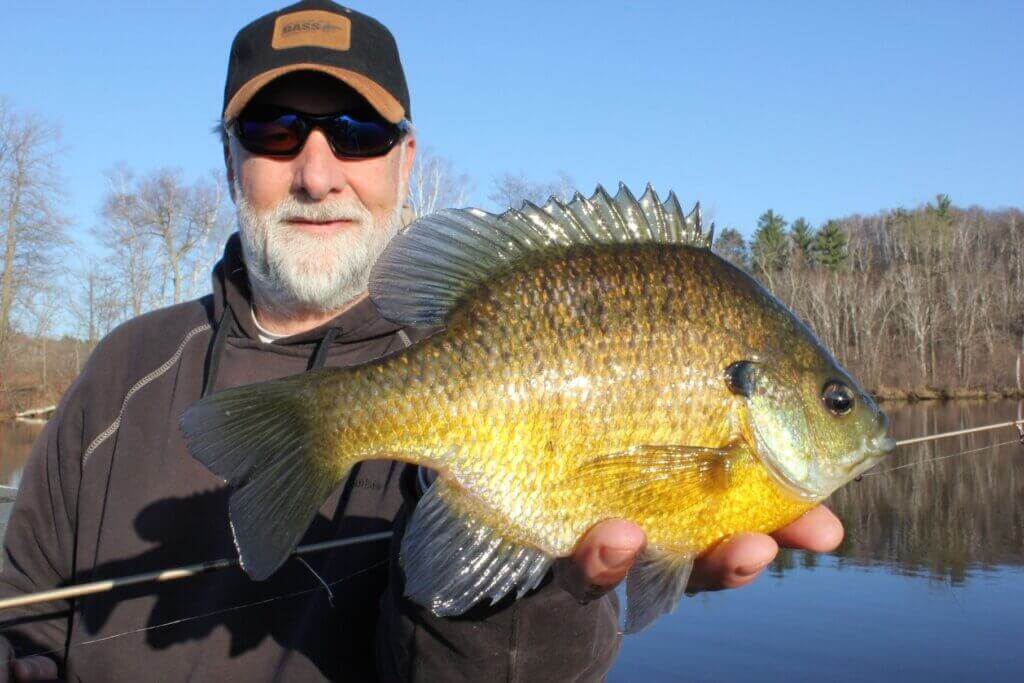
Fishing for bluegill can be an enjoyable and rewarding experience, as they are popular game fish known for their willingness to bite and their delicious taste.
Here are some details and tips for fishing bluegill:
- Tackle and Equipment. Bluegill can be caught using lightweight fishing tackle. A fishing rod and reel combo with a light or ultralight action is ideal. Spinning or spincasting reels are commonly used. Choose a fishing line with a low pound-test rating, such as 4-8 lb monofilament or fluorocarbon line. Bluegill have relatively small mouths, so using small hooks in the size range of #8 to #12 is recommended.
- Bait Selection. Bluegill are opportunistic feeders and will bite on a variety of baits. Live bait options include earthworms, crickets, mealworms, wax worms, and small minnows. Bluegill also respond well to artificial baits such as small jigs, grubs, spinners, and flies. Experiment with different baits to see what the bluegill in your fishing area prefer.
- Location and Habitat. Bluegill are often found in lakes, ponds, rivers, and streams with slow-moving or still water. Look for areas with submerged vegetation, fallen trees, docks, or other forms of structure where bluegill tend to congregate. Bluegill are also commonly found near shorelines, especially in areas with overhanging vegetation.
- Fishing Techniques. Bluegill can be caught using a variety of techniques. Casting and retrieving small jigs, spinners, or flies can be effective. Another popular technique is using a bobber or float setup with live bait. Attach a small hook and bait to the line, adjust the depth of the bait by sliding the bobber up or down the line, and cast it out. Bluegill often bite when the bait is suspended at the right depth. When you see the bobber go under or make sudden movements, it’s an indication of a bluegill bite.
- Time of Day. Bluegill are most active during early morning and late afternoon hours. They tend to be less active during the midday heat. However, bluegill can be caught throughout the day, so it’s worth trying different times to see when they are biting best in your fishing spot.
- Regulations and Limits. Familiarize yourself with local fishing regulations and limits regarding bluegill. There may be restrictions on the size of fish you can keep and the number you are allowed to catch per day.
Remember to practice ethical fishing by handling bluegill gently and releasing any undersized or unwanted fish back into the water. Fishing for bluegill can be a great way to introduce beginners to the joys of angling or enjoy a relaxing day by the water.
Lures
When it comes to lures for bluegill fishing, there are several options that can be effective in enticing these fish to bite.
Here are some details about lures commonly used for bluegill:
- Small Jigs: Small jigs are popular lures for bluegill fishing. They typically consist of a weighted head with a hook and a soft plastic or feather body. Jigs can be worked in a variety of ways, such as by casting and retrieving, jigging up and down, or slowly dragging them along the bottom. Effective colors for bluegill jigs include chartreuse, white, black, and combinations of these colors.
- Grubs: Grubs are small soft plastic baits that imitate insects or small prey fish. They can be rigged on a jig head or used with a simple hook and a split shot sinker. Grubs in natural colors like brown, green, or pumpkinseed can be effective for bluegill.
- Spinners: Spinners are lures that consist of a spinning blade attached to a shaft and a hook. The spinning blade creates flash and vibration that can attract bluegill. Choose small-sized spinners in colors like silver, gold, or white. Slowly retrieve the spinner to imitate a small baitfish or insect.
- Crankbaits: Although bluegill have small mouths, some small crankbaits can be effective in triggering their strikes. Look for small crankbaits with a tight wobble and a small lip that allows them to dive to shallow depths. Crankbaits in natural colors with patterns resembling small fish or crawfish can work well.
- Topwater Lures: Bluegill are known to strike at surface lures, especially during periods of active feeding. Popper lures, which have a concave face that creates a popping sound and splash when jerked, can be particularly effective. Additionally, small floating or diving plugs that imitate insects or small baitfish can entice bluegill to strike on the surface.
- Flies: Fly fishing for bluegill is a popular and enjoyable approach. Various fly patterns can be effective, including wet flies, dry flies, and nymphs. Bluegill tend to respond well to flies that imitate insects such as damselflies, dragonflies, mayflies, and caddisflies. Experiment with different sizes, colors, and patterns to match the local insect life.
Remember to use lighter tackle and downsized lures when targeting bluegill, as they have relatively small mouths. Adjust the size and weight of the lure based on the depth of water, fishing conditions, and the activity level of the bluegill.
As with any fishing, it’s essential to observe the behavior of the bluegill and adapt your lure presentation accordingly. Bluegill may show a preference for certain lures on a particular day, so be prepared to switch lures and experiment until you find what works best.
Here are some examples of fishing lures commonly used for bluegill fishing, along with their models and specifications:
- Bobby Garland Baby Shad: The Bobby Garland Baby Shad is a popular soft plastic lure that works well for bluegill. It is a small bait measuring around 2 inches (5 cm) in length and comes in various colors, such as Chartreuse/Black Flake, Monkey Milk, and Blue Ice. Rig it on a small jig head and fish it with a slow and subtle presentation.
- Mepps Aglia Spinner: The Mepps Aglia Spinner is a classic spinner lure that can be effective for bluegill. The size 0 or size 1 models work well, and colors like Silver, Gold, and Chartreuse are often productive. The spinner generates flash and vibration, attracting bluegill’s attention and triggering strikes.
- Rebel Crickhopper: The Rebel Crickhopper is a small crankbait designed to imitate grasshoppers and other terrestrial insects. It has a diving depth of around 2 to 3 feet (0.6 to 0.9 meters) and comes in sizes between 1 1/2 to 1 3/4 inches (3.8 to 4.4 cm). Colors like Firetiger, Cricket Frog, and Natural Brown are effective for bluegill.
- Panfish Assassin Tiny Shad: The Panfish Assassin Tiny Shad is a soft plastic bait specifically designed for panfish like bluegill. It measures around 1.5 inches (3.8 cm) and features a thin, paddle tail that produces enticing action. Colors like Black Shad, Blue Ice, and Electric Chicken can be effective choices.
- Betts Pop N’ Hot Popper: The Betts Pop N’ Hot Popper is a topwater popper lure that creates a popping sound and splash when twitched on the surface. It is available in small sizes, around 1 to 1.5 inches (2.5 to 3.8 cm), and colors like Chartreuse/Black, Yellow/Black, and White/Black. Bluegill are known to strike at this type of lure, especially during active feeding periods.
- Woolly Bugger Fly: The Woolly Bugger is a versatile fly pattern that works well for various species, including bluegill. It imitates both aquatic insects and small baitfish. Sizes 10 to 14 are commonly used, with colors like Black, Olive, and Brown being effective choices. Fish it with a slow retrieve, imparting lifelike movements to entice bluegill.
These are just a few examples of lures commonly used for bluegill fishing. There are numerous other options available in the market, so feel free to explore different models, sizes, and colors to find what works best in your fishing location and conditions.
Baits
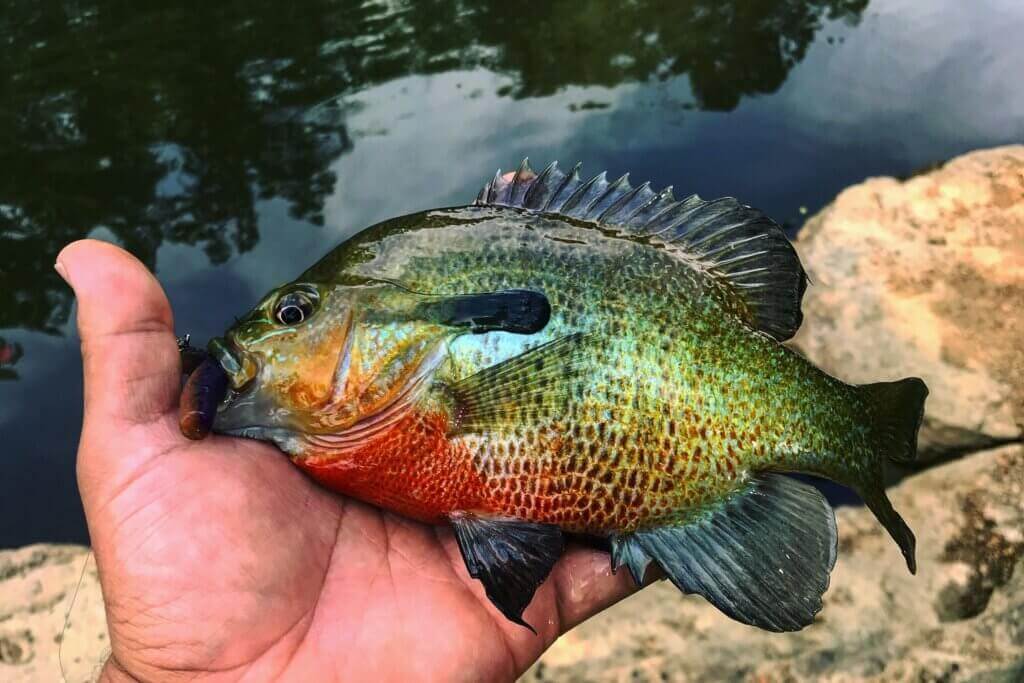
When it comes to using baits for bluegill fishing, there is a wide range of options to choose from. Bluegill are known for their willingness to bite on various baits, both natural and artificial. Here are some details about baits commonly used for bluegill:
- Live Worms: Earthworms are one of the most popular and effective baits for bluegill. Use small sections of live worms or thread them onto a small hook. Bluegill are attracted to the scent and movement of worms, making them an excellent choice.
- Crickets: Crickets are another live bait that bluegill find irresistible. Use small or medium-sized crickets and hook them through the collar or behind the head. Allow them to float or swim naturally in the water to attract bluegill.
- Mealworms: Mealworms are the larvae of darkling beetles and are readily accepted by bluegill. Thread them onto a small hook or use a bait holder. Mealworms have a wiggling action that can entice bluegill to strike.
- Wax Worms: Wax worms are the larvae of wax moths and are similar in size to mealworms. They are soft-bodied and have a sweet scent that attracts bluegill. Use them on a small hook and fish them near cover or structure.
- Minnows: Small live minnows, such as fathead minnows or rosy reds, can be effective baits for bluegill. Hook the minnow through the lips or behind the dorsal fin. Allow them to swim naturally, attracting bluegill with their movement.
- Artificial Grubs and Small Soft Plastics: Small soft plastic grubs or worms can be effective artificial baits for bluegill. Rig them on a small jig head or use a lightweight Texas or Carolina rig. These baits come in various colors and mimic natural prey, such as insects and small baitfish.
- Fly Patterns: Bluegill are also targeted using fly fishing techniques. Various fly patterns can imitate insects and small prey fish that bluegill feed on. Some popular fly patterns for bluegill include nymphs, dry flies, and wet flies in sizes 10 to 14. Effective patterns include Woolly Buggers, Hare’s Ear Nymphs, and Foam Beetles.
When fishing with baits for bluegill, it’s important to use small hooks, such as sizes 8 to 12, to match their small mouths. Also, adjust the size of the bait and the weight of your rig based on the fishing conditions and the depth at which bluegill are feeding.
Experiment with different baits to see what the bluegill in your area prefer on a given day. Keep in mind that bluegill can be selective, so having a variety of baits on hand can increase your chances of success.
Rods
When it comes to selecting a fishing rod for bluegill, there are a few factors to consider, such as the type of fishing you plan to do, personal preference, and budget.
Here are some details to help you choose a suitable fishing rod for bluegill:
- Rod Length. Bluegill fishing rods typically range from 6 to 7.5 feet (1.8 to 2.3 meters) in length. Shorter rods around 6 feet are great for close-quarters fishing, such as fishing from a dock or in tight areas with overhead cover. Longer rods provide more casting distance and better line control, making them suitable for fishing from shore or open areas.
- Rod Action. For bluegill fishing, a light or ultralight rod action is ideal. Light or fast action rods provide greater sensitivity, allowing you to detect subtle bites from bluegill. These rods also offer a softer tip, which helps in casting light baits accurately.
- Power and Line Rating. Bluegill rods are typically rated as light or ultralight power, indicating their ability to handle light lines and small fish. Look for a rod with a line rating between 2 to 6 lb (0.9 to 2.7 kg), which is suitable for bluegill fishing. Lighter lines allow for better presentation of small baits and provide a more delicate approach.
- Rod Material. Fishing rods can be made from various materials such as fiberglass, graphite, or a combination of both (composite). Graphite rods are lighter, more sensitive, and have a faster action, while fiberglass rods are more durable and offer a slower action. A graphite or composite rod is often preferred for bluegill fishing due to their sensitivity and lightness.
- Rod Handle. The handle of a bluegill fishing rod can come in different materials, including cork, EVA foam, or synthetic materials. Choose a handle material that provides a comfortable grip and allows for a firm hold during casting and fighting fish.
- Budget. Fishing rods come in a wide range of prices. Determine your budget and look for a rod that offers good value for money. While high-end rods may have some advantages in terms of sensitivity and performance, there are also many affordable options available that work well for bluegill fishing.
It’s worth noting that bluegill are relatively small fish, so a lightweight and sensitive rod is more important than raw power. A properly matched fishing rod will enhance your overall fishing experience and increase your chances of successfully hooking and landing bluegill.
Ultimately, the choice of a bluegill fishing rod will depend on your personal preferences, fishing style, and the specific fishing conditions you encounter. It’s a good idea to visit a local tackle shop or seek recommendations from experienced anglers who fish for bluegill in your area to get more specific advice on suitable rod models and brands.
Here are some examples of fishing rods commonly used for bluegill, along with their models and specifications:
- Ugly Stik GX2 Spinning Rod: The Ugly Stik GX2 is a popular spinning rod known for its durability and sensitivity. It comes in various lengths and power ratings, but for bluegill fishing, a 6 to 7-foot (1.8 to 2.1 meters) ultralight or light power rod is suitable. It features a graphite and fiberglass construction, EVA handle, and can handle line ratings of around 2 to 6 lb (0.9 to 2.7 kg).
- St. Croix Triumph Spinning Rod: The St. Croix Triumph series offers a range of spinning rods suitable for bluegill fishing. The 6 to 7-foot (1.8 to 2.1 meters) ultralight or light power models are ideal. These rods feature a premium SCII graphite construction, aluminum oxide guides, and a comfortable cork handle. Line ratings typically range from 2 to 6 lb (0.9 to 2.7 kg).
- Fenwick Eagle Spinning Rod: The Fenwick Eagle series includes ultralight and light power spinning rods suitable for bluegill fishing. These rods range from 6 to 7 feet (1.8 to 2.1 meters) in length and are constructed with graphite blanks for sensitivity and strength. They feature stainless steel guides with aluminum oxide inserts and a comfortable cork handle. Line ratings typically range from 2 to 6 lb (0.9 to 2.7 kg).
- Shimano Sellus Spinning Rod: The Shimano Sellus series offers a range of spinning rods designed for various fishing applications, including bluegill fishing. Look for models in the 6 to 7-foot (1.8 to 2.1 meters) range with ultralight or light power ratings. These rods feature a 24-ton carbon construction for sensitivity and a split-grip handle design for comfort. Line ratings typically range from 2 to 6 lb (0.9 to 2.7 kg).
- Okuma Celilo Ultralight Spinning Rod: The Okuma Celilo series offers ultralight spinning rods specifically designed for finesse fishing, making them suitable for bluegill. These rods range from 4.5 to 7 feet (1.4 to 2.1 meters) in length and feature a sensitive graphite blank construction. They have aluminum oxide guide inserts, a comfortable cork handle, and can handle line ratings of around 2 to 6 lb (0.9 to 2.7 kg).
Remember, these are just a few examples of fishing rods suitable for bluegill, and there are many other options available in the market. When selecting a rod, consider factors such as your budget, personal preference, and the specific fishing conditions you’ll encounter. It’s also beneficial to visit a local tackle shop or consult with experienced anglers in your area for more specific recommendations based on your fishing location and target species.
Dishes
Bluegill is a popular fish for culinary purposes due to its firm, white flesh and mild, sweet flavor. It can be prepared in various ways, including baking, frying, grilling, and even in soups or stews.
Here are some detailed dish ideas for cooking bluegill:
- Fried Bluegill. One of the most common and delicious ways to prepare bluegill is by frying it. To make fried bluegill, you can follow these steps:
- Clean and fillet the bluegill, removing the scales and bones.
- In a shallow dish, mix flour with your preferred seasonings like salt, pepper, and paprika.
- Dip each bluegill fillet into beaten eggs or milk and then coat it with the seasoned flour mixture.
- Heat oil in a skillet over medium heat and fry the fillets until golden brown on both sides.
- Serve the fried bluegill with tartar sauce, lemon wedges, or your favorite dipping sauce.
- Grilled Bluegill. Grilling bluegill adds a smoky flavor and a slightly crispy texture to the fish. Here’s a simple method for grilling bluegill:
- Preheat your grill to medium heat.
- Season the bluegill fillets with salt, pepper, and your choice of herbs or spices.
- Lightly oil the grill grates to prevent sticking.
- Place the bluegill fillets on the grill and cook for about 3-4 minutes per side or until the fish is cooked through and flakes easily with a fork.
- Serve the grilled bluegill with a squeeze of lemon and a side of grilled vegetables or a fresh salad.
- Baked Bluegill. Baking bluegill is a healthy and easy cooking method that keeps the fish moist and flavorful. Here’s a simple recipe for baked bluegill:
- Preheat your oven to 375°F (190°C).
- Place the bluegill fillets in a baking dish and season them with salt, pepper, and herbs like thyme or dill.
- Drizzle some olive oil or melted butter over the fillets.
- Bake the bluegill in the preheated oven for about 12-15 minutes or until the fish is cooked through and flakes easily.
- Serve the baked bluegill with a squeeze of lemon and a side of steamed vegetables or rice.
- Bluegill Chowder. Bluegill can also be used in soups or stews, such as a flavorful bluegill chowder. Here’s a basic bluegill chowder recipe:
- Sauté diced onions, celery, and carrots in a large pot with butter or oil until they are softened.
- Add peeled and cubed potatoes, chicken or fish broth, and seasonings like thyme, bay leaves, salt, and pepper.
- Simmer the mixture until the potatoes are tender.
- Add bluegill fillets, cut into bite-sized pieces, and cook for a few more minutes until the fish is cooked through.
- Stir in some heavy cream or milk and heat gently.
- Serve the bluegill chowder with crusty bread or oyster crackers.
These are just a few ideas for cooking bluegill. Feel free to get creative and explore other recipes and cooking methods that suit your taste and preferences.

